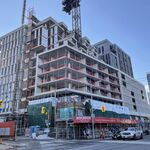Northern Light
Superstar
Another argument against converting golf courses that I just thought of: wouldn't it be cheaper to simply build on the existing utilities and infrastructure in service-rich neighbourhoods? We should be looking at revising zoning laws, and not waste our time with this kind of stopgap measure. Look at Tam O'Shanter, for example - why is the golf course there any less "urban" than the single-family homes along Kennedy Road just to the east? Maybe a view of the golf course could be a selling point for future apartments and midrises near Agincourt GO! Just combining this with promoting off-season uses should help to subsidize the summer maintenance costs.
I would argue for most of Tam O'Shanter (the floodplain portion anyway) being park space.
However, more than any other course, it does have some land outside the floodplain.
For the record, this is the density that directly abuts the golf course on its south side.
It is equally true that the north side of the course, and the east side of Kennedy are both low density.
I don't think many people here would argue with upzoning all that land; but it is up to a developer to acquire it. Unlike Tam O'Shanter those houses aren't owned by the City and therefore can't be repurposed by the City unless we've advocating expropriation.
Which, I would be open to; but that really is an entirely separate conversation from making the best use of the land the City already owns.




